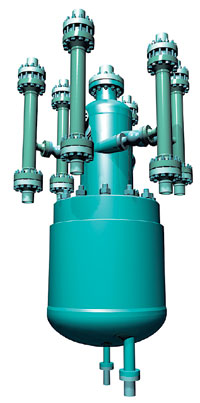 Technology from Europe: Technology from Europe:
the Netherlands
Gas conditioning technology application
The first commercial offshore Twister application successfully started up in December 2003. The supersonic technology has been selected by Petronas and Shell for the gas dehydration process of B11, a large gas processing platform 120 km offshore Malaysia. B11 field produces 600 MMscfd of sour (7 – 20 mol% CO2 and 75 – 3,500 ppmv H2S) non-associated gas and is feeding the Bintulu LNG plant. Commercialization of this technology demonstrates that it can be a competitive development option and constitutes an important milestone in obtaining industry acceptance.
Twister BV is a Shell-affiliated company based in the Netherlands offering innovative technologies and services for the natural gas processing industry. Twister is a revolutionary gas conditioning technology with thermodynamics similar to a turbo-expander, combining expansion, cyclonic gas/liquid separation and re-compression in a compact, tubular device. Condensation and separation at supersonic velocity is the key to some unique benefits.
An extremely short residence time prevents hydrate problems, eliminating chemicals and associated regeneration systems, emissions and logistics. The simplicity and reliability of a static device, with no rotating parts and operating without chemicals, ensures a simple facility with a high availability, suitable for unmanned operation. Current applications include: dehydration, hydrocarbon dewpointing, natural gas liquids extraction, and heating value reduction.
B11 concept selection. Studies for the B11 development showed that application of the new technology, compared to conventional TEG dehydration, allows smaller, lighter, cheaper, chemical-free and less-complex facilities, enabling unmanned operation. The high H2S concentration was recognized as a major hazard to personnel and a strong incentive for unmanned operation. Cost comparisons showed a reduction of 24% for the production platform topsides, compared to base-case costs.
Lifecycle cost reductions of over 40% were identified for an unmanned platform. The principal disadvantage of Twister, as per conventional expansion processes like turbo expansion and Joule Thomson expansion, was the pressure drop requirement of about 30%, which accelerates the need for field depletion compression by about two years. This can be partly mitigated by retrofitting newly developed internal designs, which provides a significantly reduced pressure drop.
 |
Twisters fitted on LTX-type Hydrate Separator.
|
|
B11 process design, subsea gas processing update. Gas from the wells arrives at the platform with pressures between 145 bar and 160 bar (2,102 psi and 2,320 psi) and is cooled from 125°C to 40°C using air coolers. Further cooling to 25°C is achieved by gas/gas cross-exchange against the cold gas exiting Twister. Liquids are separated in the inlet separator. The gas is then routed to one of the two parallel trains. Each train has six (including one spare) parallel tubes. As the tubes are effectively fixed-flow-rate devices, turndown is accommodated by bringing tubes on- or off-line as required.
In the tube, the gas is expanded and swirled to condense and concentrate the liquids. Each tube has two outlet streams, a dry primary stream and a mixed secondary stream. The secondary stream from each tube is fed into a 3-phase LTX type Hydrate Separator, equipped with heating coils to melt hydrates. The Hydrate Separator overhead gas recombines with dry gas leaving the tubes. The combined gas from the trains has a water dewpoint of 7°C or better at a pressure between 97 bar and 107 bar (1,406 psi and 1,551 psi).
Condensate (21 – 23 bbl/MMscf) is dehydrated in a combination of tilted-plate and porous media coalescers designed to meet 275-ppmv free water in condensate. After fiscal metering, the dry condensate is re-combined with the dehydrated gas export stream. The water dewpoint spec of the combined gas and condensate export stream is 14°C at 119 bara (1,726 psia), based on a minimum seabed temperature of 19°C. The pipeline normal operating pressure is between 94 bar and 104 bar (1,363 psi and 1,508 psi).
Its simplicity and reliability makes the new system the missing link for subsea gas processing and a key enabling technology for development of presently uneconomical gas reserves. Following successful completion of an initial feasibility study, Twister BV and various other partners have recently secured an EU subsidy for a four-year development program which will result in design, construction, installation and testing of the first pilot Twister subsea gas processing installation by 2007/8.
This technology won a Commendation Award from World Oil in Oct. 2002, and appeared in a technical article in World Oil's August 2002 issue. 
|

 Technology from Europe:
Technology from Europe:

